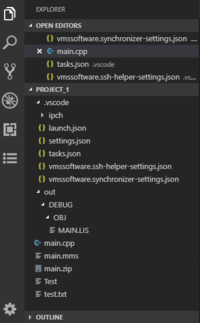VMS IDE Developing
Loading Existing Project
If you start working on an existing project that resides on OpenVMS machine, you need to download source files to your local machine. Use the Synchronizer tool as described below to download the source files.
- Change the downloadNewFiles option to overwrite.
- Run
VMS-IDE: Synchronize project files with VMScommand. - After all project files are downloaded, change the downloadNewFiles option to skip or edit to prevent silent overwriting of local files.
Managing Project Source Files
You can view and edit all project files from the Visual Studio Code Explorer. Refer to Visual Studio Code documentation to learn more about Explorer view features.
The OpenVMS project structure may look like shown below:

Managing the Project
You can manage your OpenVMS project from the Project Explorer view. To open the view, click Project Explorer icon on the Activity Bar.
Managing Dependencies
If you work on a complex project and you need to add dependencies, use the PROJET DEPENDENCIES section.
Assuming that you want to add "Project B" to "Project A" dependencies,
- Select "Project A" in the PROJET DEPENDENCIES panel.
- Right-click "Project B", and select Add to dependencies of selected item from the context menu.
To remove a project from dependencies
- Open the PROJET DEPENDENCIES section.
- Right-click the project, then select Remove from dependencies.
Building
Building MMS
In most cases, MMS file is generated automatically when running build command. If you need to create the MMS file separately, you can do this by pressing F1 and running VMS-IDE: Create MMS.
Building VMS Project
To build a project in VMS IDE:
- Open the Project Explorer view.
- Select the project you want to build in the PROJET DEPENDENCIES section.
- In the PROJET DESCRIPTION section, select the required build type (
DEBUGorRELEASE) by clicking the buildType parameter. - Right-click the project and select Build with dependencies from the context menu.
Before running build procedure VMS IDE checks that files are modified (sourceState parameter is set to modified) and there is no actual build on the server (buildState is not build). If conditions are met, VMS IDE uploads source files to the OpenVMS machine and runs build procedure. If you need to build the project, even if there are no changes, use Rebuild with dependencies.
Building with Custom Procedure
To build a project using a custom build procedure, edit the task.json file
{
"type": "task2cmd",
"command": "vmssoftware.synchronizer.buildProject",
"extension": "vmssoftware.synchronizer",
"parameter": "build.com",
"label": "Build Procedure",
"problemMatcher": []
}
where
- parameter is the name of your build procedure (COM file)
- label meaningful task name
All other parameters must be as shown in example.
NOTE: see Visual Studio Code documentation for more information on tasks.
Debugging
Use Debugger view to debug OpenVMS projects.
NOTE: Before running debugger, make sure that you have actual DEBUG builds on the OpenVMS system.
To start debugging session, press F5. If there is no "launch.json" file in the project directory, you will be asked to select the environment. Select VMS Debugger from the popup list.
The launch.json file will be created and filled with the required information. There are two types of launch configuration - DEBUG and RUN.
"configurations": [
{
"type": "vms_dbg",
"request": "launch",
"name": "Debug",
"program": "",
"arguments": "",
"stopOnEntry": true,
"typeRun": "DEBUG"
}
]
For the program field, specify the relative path to the executable, for example [.project.bin.release]hello.exe.
If the field is empty, VMS IDE will try to fill it with data from the project settings.
To choose which configuration to use, go to "Debug" (Ctrl-Shift-D) and select the appropriate configuration from the drop-down list.
Press F5 again to run debugger.